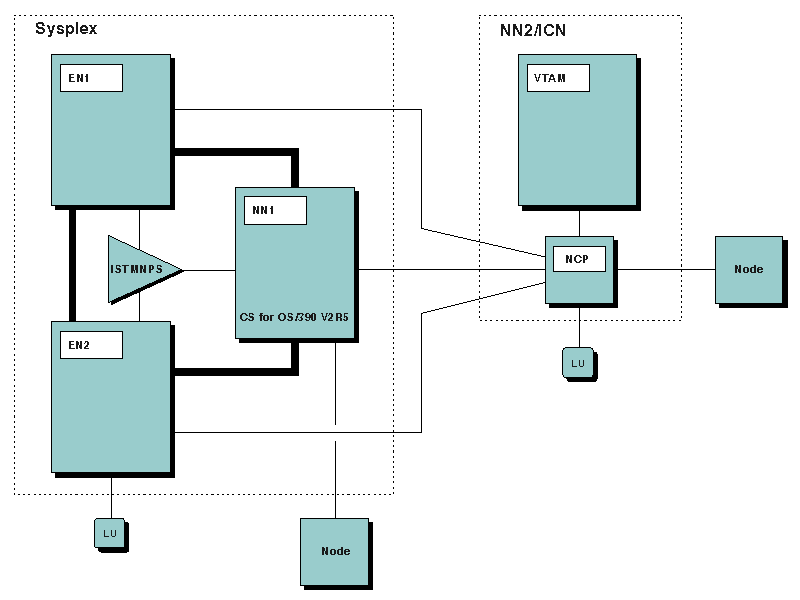Note: HALT and HALT QUICK override multinode persistent session capability
of all application programs on the VTAM® where the command is issued. HALT CANCEL will not override multinode persistent session capability. VARY INACT,TYPE=FORCE
overrides multinode persistent session capability for a specific application
program.
Following are the requirements for implementing multinode persistent
sessions:
- A persistent application program must run on a VTAM node that is part of a sysplex environment.
- VTAM nodes in the sysplex
wanting to support multinode persistent application programs must
be running under a release of MVS™ that supports coupling facility services. The coupling facility
must be using, at a minimum, coupling facility control code (CFCC)
level 1.
- All VTAMs in the multinode persistent session (MNPS) configuration
must be connected to an MVS coupling
facility in which the MNPS structure can be allocated. The MNPS coupling
facility structure stores the data and session information needed
by VTAM to recover a persistent
session.
For any MNPS using cryptography (and
assuming that ICSF is active on all nodes where the MNPS application
can operate), each z/OS® Communications
Server node that can recover an MNPS application should have the same
host master key defined so a session key enciphered at one host is
valid at the recovery host.
- In defining the structure in a CFRM policy, you specify the coupling
facility storage that should be allocated on behalf of this structure.
For information about determining the amount of storage necessary,
see Determining the size of the coupling facility structure.
- All VTAM nodes providing
multinode persistent session support must be defined as Rapid Transit
Protocol (RTP) level nodes (HPR=RTP start option).
- z/OS Communications Server
V1R6 or higher is required to implement MNPS forced takeover.
- If you are using subplexing (that is, you have specified the XCFGRPID
start option), all MNPS application recoveries must be within the
same subplex. That is, you must specify your ARM policy such that,
when recovering a failed MNPS application, the new MNPS application
instance is started within the same subplex (on a VTAM node that specified the same XCFGRPID start
option value) as the original MNPS application. In addition, the MNPS
coupling facility structure within each subplex must have a unique
name. To ensure this, the structure name specified by the STRMNPS
start option is suffixed with the 2-character XCFGRPID start option
value. You must ensure that each of these subplex structure names
is defined in the active CFRM policy. For example, if you have two
subplexes within your sysplex, one with XCFGRPID=11 and one with XCFGRPID=02,
and your STRMNPS option specifies the structure name ISTMYMNPS, you
must ensure that the CFRM policy defines both an ISTMYMNPS11 and an
ISTMYMNPS02 MNPS structure. You can display the fully suffixed MNPS
structure name accessed on a VTAM node by issuing the D NET,ID=VTAM command.
- If using APPC/MVS as a persistent application, you must specify
the PERSIST keyword. PERSIST has been added to the LUADD statement
in the APPCPMxx parmlib member. When you code this keyword, APPC/MVS
issues a persistent close when LUDEL is issued for one of its LUs.
- To receive the full benefit of multinode persistent session support,
meshed (meaning every node has a one-hop connection to every other
node in the sysplex) connectivity should exist between nodes in the
sysplex. Also, all sysplex network nodes, even if no multinode persistent
session applications plan to operate on the network node, should support
RTP tower to guarantee recoverability of sessions.
In addition,
if you plan to operate MNPS applications on the network nodes in the
sysplex, you need to extend HPR into the network beyond the sysplex.
In particular, all nodes physically adjacent to the network node or
nodes where the application can operate should be configured to perform
RTP tower function; otherwise, sessions which use paths through the
non-RTP tower nodes will not be recoverable, because there will be
no underlying HPR connection.
Figure 1. Multinode persistent session network example
Figure 1 shows an example network configuration
supporting multinode persistent sessions. EN1 and EN2 are both connected
to the coupling facility. They are using the default name for the
multinode persistent sessions structure, ISTMNPS. Also, in the sysplex
is NN1, which is the network node server for the two end nodes. Outside
of the sysplex is an interchange node, NN2, which has connections
to all of the VTAMs in the sysplex. EN1, EN2, and NN1 are all RTP-capable
nodes. It is optional for NN2 to be RTP capable; however, because
NN1 is connected to the ISTMNPS structure and MNPS applications are
anticipated to operate on NN1, NN2 should be configured to be RTP-capable
as well. This will allow HPR connections to be established from NN1
to NN2 for sessions involving MNPS applications on the network node.
Note: If you plan to use VR-based TG connectivity in the sysplex,
it is recommended that you also define at least one non-VR-based TG
connection between any end node supporting MNPS application programs
and its adjacent nodes. This will allow MNPS processing to calculate
session paths to the end node that uses the non-VR-based TG and increase
the probability that an HPR connection is used. See
Session route setup at an end node for more information.
 z/OS Communications Server: SNA Network Implementation Guide
z/OS Communications Server: SNA Network Implementation Guide
 z/OS Communications Server: SNA Network Implementation Guide
z/OS Communications Server: SNA Network Implementation Guide




 Copyright IBM Corporation 1990, 2014
Copyright IBM Corporation 1990, 2014